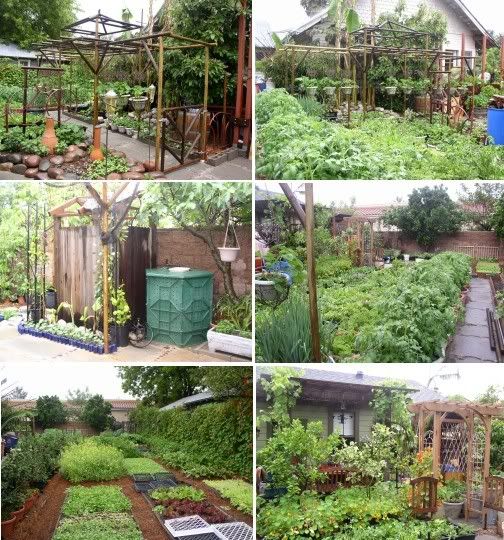From: The Texas Holistic Network
Date: Sep 15, 2008
Saving seeds, why heirloom seeds matter and moreNibiru
Scruffy: Enemy Combatant, Number One Insurgent
THINK PEACE WORLD
STRIDER
~Nita aka ~eerie
The Free Seed Exchange
Meet my newest friend, HOMEGROWN. org i did visit her site:
HOMEGROWN. org and watched this video, i highly recommend you visit too and learn a nifty city slickers simple drip irrigation technique!
Fridays at the Farm Trailer from Coyopa Productions on Vimeo.
HOMEGROWN. org – what kind of HOMEGROWN are YOU?!

__________________________________
save seeds from the garden / why heirloom seeds matter
Thank you!
Henry David Thoreau
annie
It's time to reap -- not just the garden's bounty of fruit and vegetable, nut and grain -- but also the seed for next year's garden
http://blog. oregonlive. com/homesandgardens/2008/08/save_your_seeds. html
Seeds take little storage space. One shoebox in a cool, dry place will hold your garden-in-waiting. Next spring, watch them come alive again in your garden and give some to friends to sow in their gardens, too.
Here's how:
PREPARE
• Stop deadheading flowers or harvesting vegetables to allow seedpods to form. Expect your garden to look a little untidy.
• Save seed only from standard or open-pollinated varieties. For vegetables, designate one plant of each variety for seed saving and harvest the rest.
COLLECT
Dry seed: Let seedpods dry on stalks. They will turn yellow or brown. Collect pods. In a bucket, break them open. Separate the seed from the chaff.
Wet seed: Throw tomatoes whole into a bucket. Scoop out innards of squash, melons, peppers and eggplant and throw them in a bucket. Add a little water and let them rot for several days. The flesh will separate from the seed and rise to the top. Viable seed will fall to the bottom. Pour out old water and then rinse the seed; pour it on a screen to dry. Once dry, rinse it again.
STORE
• Place clean, dry seed in paper bags, envelopes or glass jars. Baby food jars work well. Lightweight plastic bags are not moisture-proof and aren't recommended. Moisture is a seed's worst enemy.
• Label containers and keep in a cool, dry spot, 55 to 60 degrees, such as a closet in an unheated bedroom.
• Next spring, get sowing.
-- Kym Pokorny
--
Some other sources on seeds/saving
native seeds
seedsaving and seedsaver's resources
google directory of seedsavers
indigenous seed savers of new york state
Here are results from a google video search on how to save seeds... some of us learn better from seeing rather than reading... those of us with PTSD, head injuries, etc... often absorb and retain more information this way too... then there's always hands-on learning, but i guess we'll get that by doing it ourselves if we don't have others around who can teach us in person :-)
videos on how to save seeds..
--
Why it Matters to Buy Heirloom Plants and Seeds
by Annie B.Bond
http://www. care2. com/greenliving/why-buy-heirloom-plants-seeds. html
 The loss of genetic seed diversity facing us today may lead to a catastrophe far beyond our imagining. The Irish potato famine, which led to the death or displacement of two and a half million people in the 1840s, is an example of what can happen when farmers rely on only a few plant species as crop cornerstones.
The loss of genetic seed diversity facing us today may lead to a catastrophe far beyond our imagining. The Irish potato famine, which led to the death or displacement of two and a half million people in the 1840s, is an example of what can happen when farmers rely on only a few plant species as crop cornerstones.One blight wiped out the single potato type that came from deep in the Andes mountains; it did not have the necessary resistance. If the Irish had planted different varieties of potatoes, one type would have most likely resisted the blight.
We can help save heirloom seeds by learning how to buy and save these genetically diverse jewels ourselves.
ABOUT SEEDS
One kind of seed, called First generation hybrids (F1 hybrids), have been hand-pollinated, and are patented, often sterile, genetically identical within food types, and sold from multinational seed companies.
A second kind of seeds are genetically engineered. Bioengineered seeds are fast contaminating the global seed supply on a wholesale level, and threatening the purity of seeds everywhere. The DNA of the plant has been changed. A cold water fish gene could be spliced into a tomato to make the plant more resistant to frost, for example.
A third kind of seeds are called heirloom or open-pollinated, genetically diverse jewels that have been passed on from generation to generation.
With heirloom seeds there are 10,000 varieties of apples, compared to the very few F1 hyprid apple types.
The Mayan word “gene” means “spiral of life.” The genes in heirloom seeds give life to our future. Unless the 100 million backyard gardeners and organic farmers keep these seeds alive, they will disappear altogether. This is truly an instance where one person–a lone gardener in a backyard vegetable garden–can potentially make all the difference in the world.
Here are two sources for finding heirloom seeds from seed saving organizations. These organizations represent a movement of several thousand backyard gardeners who are searching the countryside for endangered vegetables, fruits and grains.
The Seed Savers Exchange
The Seed Savers Exchange (SSE), is a non-profit tax-exempt organization that is saving old-time food crops from extinction.
Kent and Diane Whealy founded SSE in 1975 after an elderly, terminally ill relative bestowed three kinds of garden seeds brought from Bavaria four generations earlier.
The Whealys began searching for other “heirloom varieties” (seeds passed down from generation to generation) and soon discovered a vast, little-known genetic treasure.
SSE’s members are maintaining thousands of heirloom varieties, traditional Indian crops, garden varieties of the Mennonite and Amish, vegetables dropped from all seed catalogs and outstanding foreign varieties. Each year hundreds of members use SSE’s publications to distribute such seeds to ensure their survival.
Each winter SSE publishes a 304-page Seed Savers Yearbook which contains names and addresses of 900 members and 6,000 listings of rare vegetable and fruit varieties that they are offering to other gardeners. Seeds are obtained by writing directly to the members who are listing those varieties.
The Seed Savers Exchange
http://www. seedsavers. org/
Native seeds/SEARCH
Native seeds/SEARCH (NS/S) is a non-profit seed conservation organization working to preserve the traditional native crops of the U.S. Southwest and Northwest Mexico. For centuries Native American farmers have grown corn, squash, beans and other crops under a variety of growing conditions.
NS/S encourages the continued use of these plants in their native habitats, and also distributes them widely to home gardeners, researchers and free of charge to Native American farmers. Wild relatives of crops–such as wild beans, chiles, gourds and cotton–are included in Native Seeds/SEARCH’s conservation efforts.
NS/S’s informative annual seed catalog lists more than 200 varieties for sale. Each crop listing includes seed saving information as well as culture and folklore.
Native seeds/SEARCH
http://www. nativeseeds. org/catalog/seedlist. html





Kindness of Strangers E_CO Member usually does environmental and nutritional education work through Donate here to Kindness of Strangers a project of the 501 (c) 3 non-profit International Humanities Center
blog
All Roads
also educate yourself about Codex
www. healthfreedomusa. com
WORD4U
Thank you
Edible Landscaping for Apartment Dwellers next
Thank you to http://www. myspace. com/consciousconsuming blogs for this video
Urban Farming
Ads are everywhere, but after this short one is a cool clip about urban farming (it's the Wall Street Journal's video) Food doesn't get more local than your own front or backyard, as Kip Nash of Community Roots in Boulder, CO explains:
From my old blog: Edible Landscaping (videos, pictures, and resources)
My friend Emily"endorses Dennis4President. com" (who has a great radio program on sustainability) posted a bulletin by our mutual friend Organic Lawns for America
"Make it your New Years Resolution to cancel your chemical lawn care service… Just by doing this there will be fewer dead birds from pesticide exposure"
And i agree if you are going to have a lawn do not use chemicals on it… Many people will chose to grow a lawn, but actually why not try an alternative?
Did you know that lawns originally became popular by the newly emerging middle class copying wealthy European estates who had the money and rainfall to support all that green?
Why not save water, mowing time, and petrochemicals used for that mower (of course we do have a push mower to loan to our neighbors)
Edible Landscaping
http://www. youtube. com/watch?v=q7JgenD4fdw
One of my favorite sights is always a front yard entirely planted with vegetables, fruits, flowers, and herbs… When we bought our first home we got rid of our lawn and planeted strawberries… Why not? The lawn wasn't doing anyone any good!
Why not use vegetables and herbs interplanted with some of the more common bedding plants? Most vegetables are actually very attractive plants which produce flowers before fruiting… Fruit trees can be espanade to grow compactly against or as a fence… Rosalind Creasy's excellent book on edible landscaping even has a picture of a fruit salad tree which you can graft to grow several varieties of fruit (my cherry tree has three varieties)


The herbs all smell wonderful I pick them and fruit while enjoying time in the garden… You maximize your growing area by planting vertically, on the top of fences, some people even have green roofs! (see video, reference, and pictures below) There are many climbing vegetable and fruits, some good ones are cucumbers, squash, tomatoes, pole beans, scarlet runner beans, edible pod peas, or hardy kiwi
Some of Terry L Yockey's (and my) favorite plants for your edible landscape are:
• Chamomile--A small daisy-like flower… The German chamomile (Matricaria recutita) is the one that you dry for chamomile tea… It isn't a perennial, but always self sows in my garden…The Roman chamomile ( (Chamaemelum nobile) ( is considered a perennial (but isn't here in Minnesota!), and has a wonderful fragrance but isn't as good in tea
• Swiss Chard--The variety 'Bright Lights' has plants in a variety of beautiful colors that will make a statement in any garden… The sun shining through the leaves looks just like stained glass… Good raw in summer salads (It grows like a weed and my rescued pet chickens "Thanks" and "Giving" love it!)
• Chives--Many people call this onion grass and it's one of the easiest herbs to grow… Its good with dips… I think it makes a nice tidy border for the perennial garden… When it gets too tall and starts to flop over, just cut it down to the ground and it will come back bigger and better
• Cucumbers--I can never resist planting these somewhere… I never get that many cukes, but I like to watch them grow and their yellow flowers are beautiful
• Basils--There are purple varieties ('Dark Opal' and 'Purple Ruffles'), lemon ('Sweet Dani') and cinnamon flavored varieties and basils with extremely large leaves such as the AAS winner 'Thai Siam Queen' or the old favorite 'Lettuce Leaf' All are worthy of a place in your yard, gardens and containers
• Monarda (Bee Balm) --My favorite flower… I grow it everywhere because of the vibrant red flowers… The leaves have a minty fragrance and can be used in your herb teas… In fact, it is said that that is what the settlers drank after the "Boston Tea Party"
• Oregano--The common oregano is a hardy ground cover that you can use for all your Italian dishes… It has pretty pink flowers that the bees love
• Parsley--Use this biennial between all your flowers in your pots… It has healthy green foliage all summer long that makes any flower next to them look even better
• Rhubarb--It's a lovely plant which doesn't deserve the soldiers-all-in-a row treatment it gets in many yards!
• Sage--It's not always reliably hardy here, but is worth replanting if necessary… A lovely silver accent in the garden which can be used often in the kitchen
• Salad Burnet ((Poterium sanguisorba) --This is a perennial that is easily grown outdoors from seed It looks like miniature ferns and tastes and smells just like a cucumber… Great for salads and for those who can't eat real cukes
• Eggplant--I grew mine in a pot this year so I could enjoy the beautiful blue flowers and purple fruits up close
Edible landscaping is a wonderful way for all of us to have productive yards (no matter how small the gardening space!)

Edible Estates: Attack on the Front Lawn,
A Project
by Fritz HaegManifesto callout, special treatment: Edible Estates is an attack on the front lawn and everything it has come to represent!
Edible Estates is an ongoing series of projects to replace the front lawn with edible garden landscapes responsive to culture, climate, context and people!
Edible Estates reconciles issues of global food production and urbanized land use with the modest gesture of a small domestic garden!
Edible Estates is a practical food-producing initiative, a place-responsive landscape design proposal, a scientific horticultural experiment, a conceptual land-art project, a defiant political statement, a community out-reach program and an act of radical gardening!
Edible Estates is nothing new; growing our own food is the first thing we did when we stopped being nomadic and started being "civilized"!
The Edible Estates project proposes the replacement of the domestic front lawn with a highly productive edible landscape… It was initiated by architect and artist Fritz Haeg on Independence Day, 2005, with the planting of the first regional prototype garden in the geographic center of the United States, Salina, Kansas
Since then three more prototype gardens have been created, in Lakewood, California; Maplewood, New Jersey and London, England… Edible Estates regional prototype gardens will ultimately be established in nine cities across the United States
Edible Estates: Attack on the Front Lawn documents the first four gardens with personal accounts written by the owners, garden plans and photographs illustrating the creation of the gardens--from ripping up the grass to harvesting a wide variety of fruits, vegetables and herbs… Essays by Haeg,landscape architect Diana Balmori, garden and food writer Rosalind Creasy, author Michael Pollan and artist and writer Lesley Stern set the Edible Estates project in the context of larger issues concerning the environment, global food production and the imperative to generate a sense of community in our urban and suburban neighborhoods… This smart, affordable and well-designed book also includes reports and photographs from the owners of other edible front yards around the country, as well as helpful resources to guide you in making your own Edible Estate


The Complete Book of Edible Landscaping: Home Landscaping with Food-Bearing Plants and Resource-Saving Techniques
Rosalind CreasyA comprehensive, feature-packed book by Rosalind Creasy, a landscape designer and leading authority on edible landscaping… This book shows how you can create more beauty around your home, grow delicious healthful produce, and save money and natural resources all at the same time - by landscaping with edible plants… It includes a 160-page "Encyclopedia of Edibles" with detailed horticultural information, landscaping and culinary uses, seed sources, and recipes, as well as an abundance of how-to illustrations and landscape diagrams… This guide incorporates energy-, water-, and soil-saving techniques with specific designs for all geographic/climatic regions of the country
Learn more about sustainable gardening
www. permaculture. com
Permaculture Part 2
PERMACULTURE-Permanent Agriculture Part 1
Permaculture Part 3
PERMACULTURE AND HARVESTING RAIN WATER VIDEOS
The Permaculture Concept Videos Parts 1-6 featuring Bill Mollison
Growing Food When The Oil Runs out
__________________________________
For those who do not know i usually do environmental and nutritional education work through Kindness of Strangers a project of the 501 (c) 3 non-profit International Humanities Center
Add my myspace site at Kindness of Strangers~Greenliving saves Wildlife
Show All Bulletins Kindness Has Posted /Subscribe to Kindness's blog
__________________________________
HOW TO REPOST THIS BULLETIN
1 Click the "Reply to Poster" button at the bottom of this post
2 Copy all the html code, create a new bulletin, paste the code in there
3 Be nice, give credit to the sender(s) when re-posting
Click "Post Comment" below and make my day :-)
----------------- Original Message -----------------
From: Eddie NWO Censored


Mel Bartholomew, Originator and Author of Square Foot Garden
Square Foot Gardening - Mel Bartholomew's Official Site
What is Square Foot Gardening?
Square foot gardening Intro
Square foot gardening - picking plants
Square foot gardening - Less weeding
Square foot gardening - what materials are needed
Square foot gardening - How to assemble pt 1
Square foot gardening - How to assemble pt 2
Square foot gardening - Layout Tips
Square foot gardening - How to Make Grids for Square Foot Gardens
Square foot gardening - What soil to use
Square foot gardening - How to layer soil
© 2025 Created by James and Terry Hamilton.
Powered by
![]()
